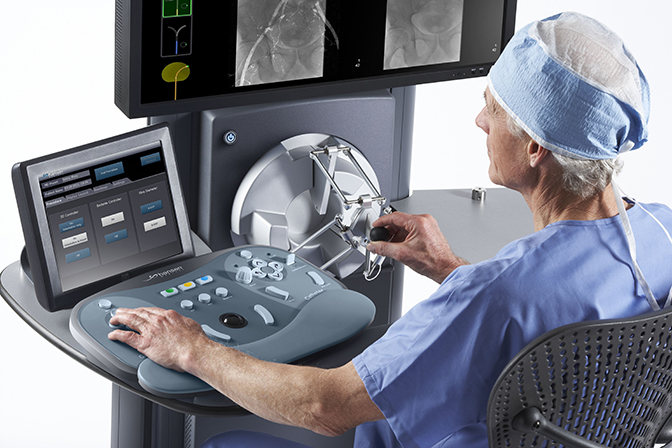Robotic-assisted interventional radiology
Images


Innovations in medical technology aim to improve patient safety and the quality of patient care. Robotic technologies in minimally invasive procedures are examples of these innovations. Currently, robotic-assisted surgical procedures are performed in several disciplines, including general, cardiothoracic and urologic surgery.
Robotic assistance in interventional radiology procedures is gaining traction rapidly. An emerging clinical practice is closely following the growth of the robotic interventional healthcare industry. This industry is focused on revolutionizing how interventional procedures are performed.
Currently, robotic assistance can be combined with ultrasound, magnetic resonance imaging (MRI), computed tomography (CT), and fluoroscopy. The advantages of robotic assistance in interventional procedures with these modalities are clear: greater operator precision and control. This improved accuracy can lead to reduced procedural time, radiation exposure, recovery time, procedural complications and mortality. An additional advantage is remote operator use. Tele-operation can reduce radiation exposure to the operator and also afford remote patient access. The latter could be of value when operator assistance is needed.
Researchers have focused on such areas as image-guided biopsies, ablations, and endovascular interventions. Robotic-assisted biopsies and ablations are performed with a tableor patient-mounted robotic device. In a phantom model assessing needle insertions for CT-guided biopsies and radiofrequency ablation, Koethe et al found improved needle-placement accuracy with lower needle tip-to-target errors with the robot assisted platform.1 In a recent study of 100 patients undergoing either robot-assisted or conventional lung biopsy, Anzidei et al found that procedure duration and radiation dose were significantly lower in the robot-assisted group, without a significant impact on biopsy diagnostic performance or complications.2 Stoianovici et al have reported on the development of an MRI-safe robot for image-guided endorectal prostate biopsies with 3 degrees of freedom. Researchers found acceptable accuracy with no deterioration in image quality or signal-to-noise ratio.3
Endovascular robotic-assisted procedures are performed with a disposable catheter inserted percutaneously and then navigated and manipulated remotely. In 15 patients undergoing robot-assisted diagnostic catheter cerebral angiography, Lu et al reported accurate catheter placements with a decrease in operational time and an absence of operator radiation exposure.4 In 20 illio-femoral arterial systems with stenotic-occlusive disease, Bismuth et al reported successful robot assisted target lesion navigation and cannulation without adverse events.5 In 5 women undergoing robot-assisted bilateral uterine artery embolization, Rolls et al reported safe clinical use and complete technical success in all patients.6
The disadvantages of robotic interventional radiology using current technology include higher procedural costs, longer pre-procedural preparation, and the need for additional staff. Moreover, the absence of operator intraprocedural tactile feedback could lead to visceral and vascular injuries. With continued innovation, core costs can be expected to decrease. Staff education and training will optimize procedural efficiency. Continued research on tactile feedback and application to robotic steerable catheters and biopsy systems should minimize potential iatrogenic injuries.7
As with all innovations in health care, quality control and assurance measures will be required. These include guidelines on appropriate use, technical performance, and physician and technologist training. Through these measures and continued research and development, the future of interventional radiology will be defined by safe clinical use of robotic technology. During strategic planning sessions in 2016, interventionalists and healthcare administrators should embrace this exciting innovation for its ability to enhance interventional radiology and the care of patients.
References
- Koethe Y, Xu S, Velusamy G, Wood BJ, Venkatesan AM. Accuracy and efficacy of percutaneous biopsy and ablation using robotic assistance under computed tomography guidance: a phantom study. Eur Radiol. 2014; 24(3):723-730
- Anzidei M, Argiro R, Porfiri A, Boni F, et al. Preliminary clinical experience with a dedicated interventional robotic system for CT-guided biopsies of lung lesions: a comparison with the conventional manual technique. Eur Radiol. 2015;25(5):1310-1316.
- Stoianovici D, Kim C, Srimathveeravalli G, Sebrecht P, et al. MRI-Safe Robot for Endorectal Prostate Biopsy. IEEE ASME Trans Mechatron. 2013; 19(4):1289-1299
- Bismuth J, Duran C, Stankovic M, Gersak B, Lumsden AB. A first-in-man study of the role of flexible robotics in overcoming navigation challenges in the iliofemoral arteries. J Vasc Surg. 2013;57(2Suppl):14S-9S
- Rolls AE, Riga CV, Bicknell CD, Regan L, Cheshire NJ, Hamady MS, Robot-Assisted Uterine Artery Embolization: A First-in-Woman Safety Evaluation of the Magellan System. J Vasc Interv Radiol. 2014; 25(12):1841-1848
- Lu WS, Xu WY, Pan F, Liu D, at al. Clinical application of a vascular interventional robot in cerebral angiography. Int J Med Robot. 2015; Mar 17 (Epub ahead of print).
- Wottawa CR, Genovese B, Nowroozi BN, Hart SD, et al. Evaluating tactile feedback in robotic surgery for potential clinical application using an animal model. Surg Endosc. 2015 Oct 30 (Epub ahead of print).
Citation
JC H. Robotic-assisted interventional radiology. Appl Radiol. 2016;(1):28-29.
January 7, 2016